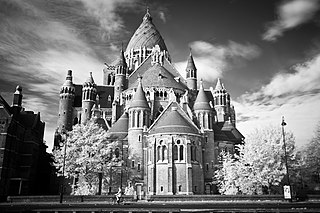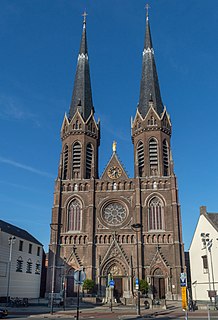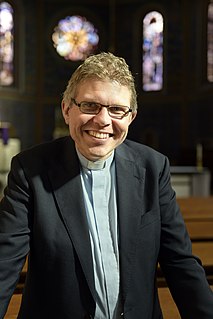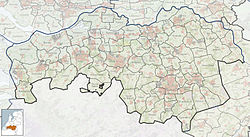
The Nieuwe Kerk is a 15th-century church in Amsterdam located on Dam Square, next to the Royal Palace. Formerly a Dutch Reformed Church parish, it now belongs to the Protestant Church in the Netherlands.

Koningsbosch is a village within the municipality of Echt-Susteren, in the Dutch province of Limburg. Koningsbosch is located next to the German border, approximately 10 kilometres east of the town of Echt.

The Cathedral of Saint Bavo is a cathedral in Haarlem, the Netherlands, built by Joseph Cuypers from 1895 to 1930 to replace the former waterstaatskerk in the Jansstraat called the St. Joseph. That church was itself a replacement for the Sint-Bavokerk, that had been converted to Protestantism from Catholicism in 1578. The Cathedral of Saint Bavo now serves as the main cathedral for the Roman Catholic Diocese of Haarlem-Amsterdam. Within the cathedral, the former sacristy has been converted into a small museum (schatkamer) containing historical artefacts from Haarlem's Catholic past.

The Catholic Cathedral Church of St. John (Sint-Janskathedraal) of 's-Hertogenbosch, North Brabant, is the height of Gothic architecture in the Netherlands. It has an extensive and richly decorated interior, and serves as the cathedral for the bishopric of 's-Hertogenbosch.

Gemert is a town in the Dutch province of North Brabant. It is located in the municipality of Gemert-Bakel.

The Nieuwe Kerk is a Protestant church in the city of Delft in the Netherlands. The building is located on Delft Market Square (Markt), opposite to the City Hall. In 1584, William the Silent was entombed here in a mausoleum designed by Hendrick and Pieter de Keyser. Since then members of the House of Orange-Nassau have been entombed in the royal crypt. The latest are Queen Juliana and her husband Prince Bernhard in 2004. The private royal family crypt is not open to the public. The church tower, designed by Pierre Cuypers and completed in 1872, is the second highest in the Netherlands, after the Domtoren in Utrecht.

The Catholic Church in the Netherlands is part of the worldwide Catholic Church under the spiritual leadership of the Pope in Rome. Its primate is the Metropolitan Archbishop of Utrecht, currently Willem Jacobus Eijk since 2008. In 2015 Catholicism was the single largest religion of the Netherlands, forming some 23% of the Dutch people, based on in-depth interviewing, down from 40% in the 1960s.

The Oude Kerk, nicknamed Oude Jan and Scheve Jan, is a Gothic Protestant church in the old city center of Delft, the Netherlands. Its most recognizable feature is a 75-meter-high brick tower that leans about two meters from the vertical.

Jan Stuyt was a Dutch architect.

The Roman Catholic Diocese of Rotterdam is a Latin diocese of the Catholic Church in South Holland province of the Netherlands. The diocese is a suffragan in the ecclesiastical province of the Metropolitan Archbishop of Utrecht. Since 2011, the bishop has been Hans van den Hende.
Jonkheer Eduard Anton Eugène van Meeuwen was a Dutch lawyer and vice-president of the Court of 's-Hertogenbosch.

The Hooglandse Kerk is a Gothic church in Leiden. Its earliest parts date back to the last quarter of the fourteenth century. Most of the current structure dates from the fifteenth century. The brick church was dedicated to St. Pancras and today serves parishioners of the Protestant Church in the Netherlands.

The Basilica of Our Lady is a Romanesque church in the historic center of Maastricht, Netherlands. The church is dedicated to Our Lady of the Assumption and is a Roman Catholic parish church in the Diocese of Roermond. The church is often referred to as the Star of the Sea, after the church's main devotion, Our Lady, Star of the Sea.

TSV NOAD was an association football club based in Tilburg, Netherlands. Founded in 1910, the club played at the highest level of Dutch football between 1918 and 1961.

The James the Greater Church is a Roman Catholic church, located on the Pastoor Neujeanstraat 6 in Bocholtz, Netherlands. First mentioned in the 14th century, the current church was built in 1869 by Pierre Cuypers. It was extended by Harry Koene in 1953, creating a larger choir, and adding an apse and sacristy. The building has been in continues use as a parish church for the Bocholtz saint James the Greater parish since 1873. The church holds a relic of pope Cornelius, which was subject of a yearly pilgrimage during the early and mid 20th century, and was listed as a national monument in 1967.

The Heilige Lodewijkkerk, also called the St. Louis Church, is a Roman Catholic church at the Steenschuur in Leiden.

St. Joseph Church is the largest Roman Catholic parish church still in use in Leiden in the diocese of Rotterdam. It is also called the Herensingelkerk, because it is situated at the street called Herensingel. The church is a national heritage site and one of the tallest buildings in the centre of Leiden.

The Heuvelse kerk is a neo-Gothic Catholic church in the center of the Dutch city Tilburg. Dedicated to Saint Joseph, it is one of two major Catholic churches in the city center together with the Heikese kerk. It is located along the square Heuvel, after which it is named. A 1921 statue of the Sacred Heart is located in front of the building.

Bernd Wallet serves as the 84th Archbishop of Utrecht of the Old Catholic Church of the Netherlands. Elected on 15 February 2020, he was consecrated on 18 September 2021, after two delays due to the COVID-19 pandemic.

Charles Hubert Eyck was a Dutch visual artist. Together with Henri Jonas and Joep Nicolas, he was a pioneer of the so-called Limburg School.



























